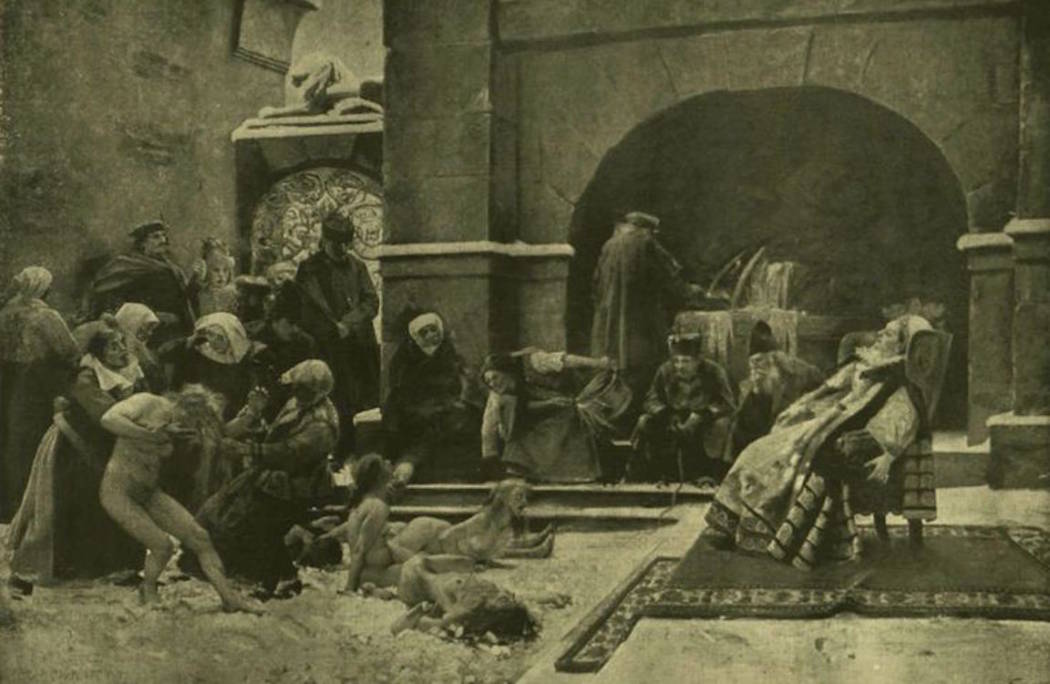jonesygirl
Tribunica Potestas
Haggling
The man on the right is haggling with Ingrid over the price of his potential purchase of witch meat. This would not normally happen as the cost of basic foodstuffs was fixed by law. The price of manufactured goods on the other hand depended to a large extent on supply and demand. As an example you would expect to pay 2d for a chicken but £50 for a top of the range dress. However, Little Brampton was a law unto itself!

“Dame, what hold ye the udder of this
cow? Or what is worth the pair together?
In short, so to speak, how much the pair?”
“Sire, reason; ye shall have it good and cheap.”
“Yea, truly, for cattle. Dame, ye must me win.
Take heed what I shall pay.”
“Six pennies, if it please you.”
“For so much would I have the finest wine.”
“But I have some which is not of the best
which I would not give for a shilling.”
“But this is no such meat, of so much money,
that know ye well!”
“Sire, what is it worth?”
“Dame, it were worth to me well three pennies.”
“That is evil-boden.”
“But say certainly how shall I have it without
a part to leave?”
“I shall give it ye at one word: ye shall pay one groat.”
(One groat=4d. There were 240d to the £ and £1 is approx $1.25 so how much is 1 groat in $ ?)
The girl with the knife is Lucy, Ingrid’s niece who is working her Saturday morning job on Ingrid’s witch meat stall. Another hour and she’ll have enough to go to the concert by the “Mediaeval Baebes” on the village green. Perhaps they’ll sing “Salve virgo virginum” or maybe the popular “Guadete”.
A cow’s udder was considered as offal and sold as such. For a long time it was an acquired taste like tripe and pickled sheep’s brain. As recently as the 1950’s it was eaten over here, warmed up and served with brown bread and butter. Not all were fans of the stuff.
Parson James Woodforde was still at Oxford on this day in 1763, and wrote:
“I dined at the Chaplain’s table with Pickering and Waring, upon a roasted Tongue and Udder…N.B. I shall not dine on a roasted Tongue and Udder again soon”
Tongue and udder were both common items of diet at the time and the good Parson ate tongue regularly over the next forty years, so it must have been the udder that was the problem. Samuel Pepys certainly enjoyed it a hundred years earlier:
“Mr. Creed and I to the Leg in King Street, where he and I, and my Will had a good udder to dinner.”
It was often sold cheaply, minced, cooked and used in pies as a thickener. In Medieval times not only was the price of foodstuff fixed but there were laws governing the sale and quality of edible products. You bought it fresh and ate it soon. Woe betide a butcher whose products made his customers ill. They knew where you lived! Not so the case in larger cities. Today we have many food laws. Sadly, most of them favour the seller rather than the consumer. Your pie may have been thickened with “Meat products”. But what are those? Hardly any pizzas contain real cheese and lamb curries are anything but!
Bon Appetite
The man on the right is haggling with Ingrid over the price of his potential purchase of witch meat. This would not normally happen as the cost of basic foodstuffs was fixed by law. The price of manufactured goods on the other hand depended to a large extent on supply and demand. As an example you would expect to pay 2d for a chicken but £50 for a top of the range dress. However, Little Brampton was a law unto itself!

“Dame, what hold ye the udder of this
cow? Or what is worth the pair together?
In short, so to speak, how much the pair?”
“Sire, reason; ye shall have it good and cheap.”
“Yea, truly, for cattle. Dame, ye must me win.
Take heed what I shall pay.”
“Six pennies, if it please you.”
“For so much would I have the finest wine.”
“But I have some which is not of the best
which I would not give for a shilling.”
“But this is no such meat, of so much money,
that know ye well!”
“Sire, what is it worth?”
“Dame, it were worth to me well three pennies.”
“That is evil-boden.”
“But say certainly how shall I have it without
a part to leave?”
“I shall give it ye at one word: ye shall pay one groat.”
(One groat=4d. There were 240d to the £ and £1 is approx $1.25 so how much is 1 groat in $ ?)
The girl with the knife is Lucy, Ingrid’s niece who is working her Saturday morning job on Ingrid’s witch meat stall. Another hour and she’ll have enough to go to the concert by the “Mediaeval Baebes” on the village green. Perhaps they’ll sing “Salve virgo virginum” or maybe the popular “Guadete”.
A cow’s udder was considered as offal and sold as such. For a long time it was an acquired taste like tripe and pickled sheep’s brain. As recently as the 1950’s it was eaten over here, warmed up and served with brown bread and butter. Not all were fans of the stuff.
Parson James Woodforde was still at Oxford on this day in 1763, and wrote:
“I dined at the Chaplain’s table with Pickering and Waring, upon a roasted Tongue and Udder…N.B. I shall not dine on a roasted Tongue and Udder again soon”
Tongue and udder were both common items of diet at the time and the good Parson ate tongue regularly over the next forty years, so it must have been the udder that was the problem. Samuel Pepys certainly enjoyed it a hundred years earlier:
“Mr. Creed and I to the Leg in King Street, where he and I, and my Will had a good udder to dinner.”
It was often sold cheaply, minced, cooked and used in pies as a thickener. In Medieval times not only was the price of foodstuff fixed but there were laws governing the sale and quality of edible products. You bought it fresh and ate it soon. Woe betide a butcher whose products made his customers ill. They knew where you lived! Not so the case in larger cities. Today we have many food laws. Sadly, most of them favour the seller rather than the consumer. Your pie may have been thickened with “Meat products”. But what are those? Hardly any pizzas contain real cheese and lamb curries are anything but!
Bon Appetite















